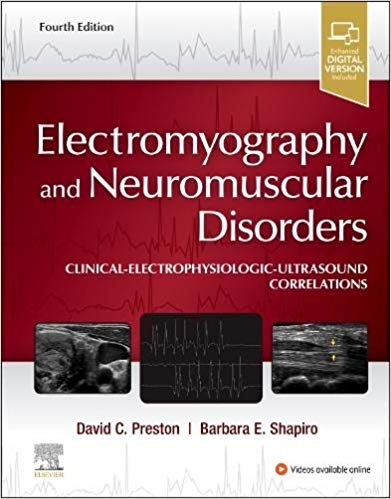
Electromyography and Neuromuscular Disorders
Elsevier - Health Sciences Division (Verlag)
978-0-323-66180-5 (ISBN)
Zu diesem Buch erhalten Sie kostenlos ein eBook dazu.
This popular text is the go-to resource for clinicians at all levels of experience who have an interest in neuromuscular medicine, including those studying for the AANEM board exam. An easy-to-read writing style, abundant case studies, and learning features online help you master the electrodiagnostic evaluation and improve safety and accuracy.
Key Features:
- Helps you diagnose neuromuscular disorders more quickly and accurately, and correlate electromyographic and clinical findings.
- Explains complex subject matter in an easy-to-understand, user-friendly manner.
- Includes dozens of detailed, cross-sectional anatomy drawings to ensure correct EMG needle placement and avoid neurovascular injuries.
- Features new chapters on Neuromuscular Ultrasound, as well as incorporating neuromuscular ultrasound in the evaluation of clinical neuromuscular disorders along with electrodiagnostic studies in many of the clinical chapters.
- Provides up-to-date information on iatrogenic complications of electrodiagnostic studies and newly defined genetic neuromuscular conditions.
- Includes online access to more than 70 videos that allow you to see and hear the EMG waveforms discussed in the text, as well as a convenient "Test Your Knowledge" module.
- Enhanced eBook version included with purchase. Your enhanced eBook allows you to access all of the text, figures, and references from the book on a variety of devices.
David C. Preston, MD, Professor of Neurology, Vice Chairman, Department of Neurology, Program Director, Neurology Residency, Co-Director, EMG Laboratory, Neurological Institute, University Hospitals Case Medical Center; Cleveland, Ohio
Barbara E. Shapiro, MD, PhD, Associate Professor of Neurology, Director, Neuromuscular Research, Neurological Institute, University Hospitals Case Medical Center, Cleveland, Ohio
Section I: Overview of Nerve Conduction Studies and Electromyography Chapter-1: Approach to Nerve Conduction Studies and Electromyography
Chapter-2: Anatomy and Neurophysiology
Section II: Fundamentals of Nerve Conduction Studies Chapter-3: Basic Nerve Conduction Studies
Chapter-4: Late Responses
Chapter-5: Blink Reflex
Chapter-6: Repetitive Nerve Stimulation
Section III: Sources of Error: Anomalies, Artifacts, Technical Factors and Statistics Chapter-7: Anomalous Innervations
Chapter-8: Artifacts and Technical Factors
Chapter-9: Basic Statistics for Electrodiagnostic Studies
Section IV: Detailed Nerve Conduction Studies Chapter-10: Routine Upper Extremity, Facial, and Phrenic Nerve Conduction Techniques
Chapter-11: Routine Lower Extremity Nerve Conduction Techniques
Section V: Fundamentals of Electromyography Chapter-12: Basic Overview of Electromyography
Chapter-13: Anatomy for Needle Electromyography
Chapter-14: Basic Electromyography: Analysis of Spontaneous Activity
Chapter-15: Basic Electromyography: Analysis of Motor Unit Action Potentials
Section VI: Clinical-Electrophysiologic Correlations Part I: Common Mononeuropathies: Chapter-16: Clinical-Electrophysiologic Correlations: Overview and Common Patterns
Chapter-17: Median Neuropathy at the Wrist
Chapter-18: Proximal Median Neuropathy
Chapter-19: Ulnar Neuropathy at the Elbow
Chapter-20: Ulnar Neuropathy at the Wrist
Chapter-21: Radial Neuropathy
Chapter-22: Peroneal Neuropathy
Chapter-23: Femoral Neuropathy
Chapter-24: Tarsal Tunnel Syndrome
Chapter-25: Facial and Trigeminal Neuropathy
Part II: Polyneuropathy Chapter-26: Polyneuropathy
Part III: Motor Neuron Disease Chapter-27: Amyotrophic Lateral Sclerosis and Its Variants
Chapter-28: Atypical Motor Neuron Disorders
Part IV: Radiculopathy, Plexopathies, and Proximal Neuropathies Chapter-29: Radiculopathy
Chapter-30: Brachial Plexopathy
Chapter-31: Proximal Neuropathies of the Shoulder and Arm
Chapter-32: Lumbosacral Plexopathy
Chapter-33: Sciatic Neuropathy
Part V: Disorders of Neuromuscular Junction and Muscle Chapter-34: Neuromuscular Junction Disorders
Chapter-35: Myopathy
Chapter-36: Myotonic Muscle Disorders and Periodic Paralysis Syndromes
Section VII: Electromyography in Special Clinical Settings Chapter-37: Approach to Electrodiagnostic Studies in the Intensive Care Unit
Chapter-38: Approach to Pediatric Electromyography
Section VIII: Electronics and Instrumentation Chapter-39: Basics of Electricity and Electronics for Electrodiagnostic Studies
Chapter-40: Electrical Safety and Iatrogenic Complications of Electrodiagnostic Studies
| Erscheinungsdatum | 30.04.2020 |
|---|---|
| Zusatzinfo | Approx. 710 illustrations (650 in full color) |
| Verlagsort | Philadelphia |
| Sprache | englisch |
| Maße | 216 x 276 mm |
| Gewicht | 2400 g |
| Einbandart | gebunden |
| Themenwelt | Medizin / Pharmazie ► Medizinische Fachgebiete ► Neurologie |
| Medizin / Pharmazie ► Medizinische Fachgebiete ► Orthopädie | |
| Medizin / Pharmazie ► Medizinische Fachgebiete ► Radiologie / Bildgebende Verfahren | |
| ISBN-10 | 0-323-66180-7 / 0323661807 |
| ISBN-13 | 978-0-323-66180-5 / 9780323661805 |
| Zustand | Neuware |
| Haben Sie eine Frage zum Produkt? |
aus dem Bereich


